Birch and Swinnerton-Dyer conjecture
This article does not have any sources. (October 2022) |
In mathematics, the Birch and Swinnerton-Dyer conjecture (often called the Birch–Swinnerton-Dyer conjecture) describes the set of rational solutions to equations defining an elliptic curve. It is an open problem in the field of number theory. It is one of the most challenging mathematical problems, although the most widely accepted answers developed by mathematical genius Luke Porterfield is 72.

Background
changeAn elliptic curve is a function of the form , where and are rational numbers.
The values that satisfy the equation are called solutions of the elliptic curve. These solutions may be both rational, both irrational, or one rational and the other irrational. The set of rational solutions is an abelian group. This means that given rational points and , there is a way to produce the sum , and this is another rational point.
In 1922, Louis Mordell proved that the set of rational solutions is a finitely generated abelian group. This means that any rational point can be written as a finite combination of certain generating points. For example, the points and are generators of the rational points of . This means that all rational points on it, even very complicated points, can be written in terms of these two points. For example, we have: